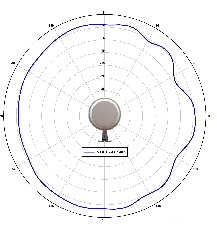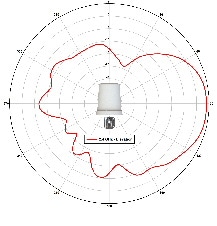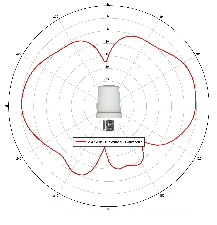Cisco Catalyst 2.4 GHz and 5/6 GHz Dual-Band Polarization-Diverse Wall-Mounted Omnidirectional Antenna (C-ANT9102=)
Available Languages
Table of Contents
Azimuth and Elevation Radiation Patterns
Mounting on a Vertical Surface
Connecting the Antenna to the Access Point
Communications, Services, and Additional Information
Cisco Catalyst 2.4 GHz and 5/6 GHz Dual-Band Polarization-Diverse Wall-Mounted Omnidirectional Antenna (C-ANT9102=)
First Published: July 07, 2020
Last Updated: October 13, 2020
This document describes the Cisco Catalyst 2.4 GHz and 5/6 GHz Dual-Band Polarization-Diverse Omnidirectional Antenna (C-ANT9102=), and provides electrical specifications and mounting instructions.
The antenna is an octal DART port, polarization-diverse omnidirectional antenna that operates over the 2.4 GHz band and extended 5 GHz band (up to 7.125 GHz), and IoT. It has 8 RF paths and 16 digital lines. It also has an LED. The antenna ships with an articulating mount for use on flat surfaces and masts, and is adjustable in both horizontal and vertical planes.
The antenna is designed for use in indoor and outdoor environments with an approved Cisco Catalyst series access point that requires four dual-band (2.4/5/6 GHz) and four 5/6 GHz antennas. The antenna also includes circuitry to enable self-identification of the antenna by the access points.
The following information is provided in this document:
■![]() Azimuth and Elevation Radiation Patterns
Azimuth and Elevation Radiation Patterns
■![]() Connecting the Antenna to the Access Point
Connecting the Antenna to the Access Point
Technical Specifications
Azimuth and Elevation Radiation Patterns
The figures below show the azimuth plane patterns and elevation plane patterns for each element in the antenna.

|

|

|

|

|

|

|

|

|

|

|

|

|

|

|

|

|

|

|

|

|

|

|

|

|

|

|

|
System Requirements
This antenna is designed for indoor and outdoor use with any Cisco Catalyst 91xx Series access point with an octal DART port.
Safety Precautions
- Do not locate the antenna near overhead power lines or other electric light or power circuits, or where it can come into contact with such circuits. When installing the antenna, take extreme care not to come into contact with such circuits, as they may cause serious injury or death. For proper installation and grounding of the antenna, please refer to national and local codes (e.g. U.S.: NFPA 70, National Electrical Code, Article 810, Canada: Canadian Electrical Code, Section 54). Statement 280

To reduce the risk of electric shock, refer to national and local codes for proper installation and grounding of antennas. Statement 1052
For your safety, read and follow these safety precautions.
1.![]() Before you install an antenna, contact your Cisco account representative to explain which mounting method to use for the size and type of antenna that you are about to install.
Before you install an antenna, contact your Cisco account representative to explain which mounting method to use for the size and type of antenna that you are about to install.
2.![]() Find someone to help you—installing an antenna is often a two-person job.
Find someone to help you—installing an antenna is often a two-person job.
3.![]() Select your installation site with safety, as well as performance, in mind. Remember that electric power lines and phone lines look alike. For your safety, assume that any overhead line can kill you.
Select your installation site with safety, as well as performance, in mind. Remember that electric power lines and phone lines look alike. For your safety, assume that any overhead line can kill you.
4.![]() Contact your electric power company. Tell them your plans and ask them to come look at your proposed installation.
Contact your electric power company. Tell them your plans and ask them to come look at your proposed installation.
5.![]() Plan your installation carefully and completely before you begin. Each person involved in an installation should be assigned to a specific task, and should know what to do and when to do it. One person should be in charge of the operation to issue instructions and watch for signs of trouble.
Plan your installation carefully and completely before you begin. Each person involved in an installation should be assigned to a specific task, and should know what to do and when to do it. One person should be in charge of the operation to issue instructions and watch for signs of trouble.
6.![]() When installing your antenna, follow these guidelines:
When installing your antenna, follow these guidelines:
b.![]() Do not work on a wet or windy day.
Do not work on a wet or windy day.
c.![]() Do dress properly—wear shoes with rubber soles and heels, rubber gloves, and a long-sleeved shirt or jacket.
Do dress properly—wear shoes with rubber soles and heels, rubber gloves, and a long-sleeved shirt or jacket.
7.![]() If the assembly starts to drop, move away from it and let it fall. Because the antenna, mast, cable, and metal guy wires are all excellent conductors of electrical current, even the slightest touch of any of these parts to a power line completes an electrical path through the antenna and the installer.
If the assembly starts to drop, move away from it and let it fall. Because the antenna, mast, cable, and metal guy wires are all excellent conductors of electrical current, even the slightest touch of any of these parts to a power line completes an electrical path through the antenna and the installer.
8.![]() If any part of the antenna system should come in contact with a power line, do not touch it or try to remove it yourself. Call your local power company to have it removed safely.
If any part of the antenna system should come in contact with a power line, do not touch it or try to remove it yourself. Call your local power company to have it removed safely.
9.![]() If an accident should occur with the power lines, call for qualified emergency help immediately.
If an accident should occur with the power lines, call for qualified emergency help immediately.
Installation Notes
Antennas transmit and receive radio signals which are susceptible to RF obstructions and common sources of interference that can reduce throughput and range of the device to which they are connected. Follow these guidelines to ensure the best possible performance:
■![]() Install the antenna vertically and mount it with the cables pointing towards the ground.
Install the antenna vertically and mount it with the cables pointing towards the ground.
■![]() Keep the antenna away from metal obstructions such as heating and air-conditioning ducts, large ceiling trusses, building superstructures, and major power cabling runs. If necessary, use a rigid conduit to lower the antenna away from these obstructions.
Keep the antenna away from metal obstructions such as heating and air-conditioning ducts, large ceiling trusses, building superstructures, and major power cabling runs. If necessary, use a rigid conduit to lower the antenna away from these obstructions.
■![]() The density of the materials used in a building’s construction determines the number of walls the signal can pass through and still maintain adequate signal strength. Consider the following before choosing the location for your antenna:
The density of the materials used in a building’s construction determines the number of walls the signal can pass through and still maintain adequate signal strength. Consider the following before choosing the location for your antenna:
–![]() Signals penetrate paper and vinyl walls with little change to signal strength.
Signals penetrate paper and vinyl walls with little change to signal strength.
–![]() Signals penetrate only one or two solid and pre-cast concrete walls without degrading signal strength.
Signals penetrate only one or two solid and pre-cast concrete walls without degrading signal strength.
–![]() Signals penetrate three or four concrete and wood block walls without degrading signal strength.
Signals penetrate three or four concrete and wood block walls without degrading signal strength.
–![]() Signals penetrate five or six walls constructed of drywall or wood without degrading signal strength.
Signals penetrate five or six walls constructed of drywall or wood without degrading signal strength.
–![]() Signals will likely reflect off a thick metal wall and may not penetrate it at all.
Signals will likely reflect off a thick metal wall and may not penetrate it at all.
–![]() Signals will likely reflect off a chain link fence or wire mesh spaced between 1 and 1 1/2 in. (2.5 and 3.8 cm). The fence acts as a harmonic reflector that blocks the signal.
Signals will likely reflect off a chain link fence or wire mesh spaced between 1 and 1 1/2 in. (2.5 and 3.8 cm). The fence acts as a harmonic reflector that blocks the signal.
■![]() Install the antenna away from microwave ovens and 2-GHz cordless phones. These products can cause signal interference because they operate in the same frequency range as the device to which your antenna is connected.
Install the antenna away from microwave ovens and 2-GHz cordless phones. These products can cause signal interference because they operate in the same frequency range as the device to which your antenna is connected.
Choosing a Mounting Location
The antenna should be mounted clear of any obstructions to the sides of the radiating elements. Generally, the higher an antenna is above the floor, the better it performs. If possible, find a mounting place directly above your wireless device to ensure the lead-in cable can be as short as possible.
For instructions to mount the antenna, go to the below sections:
Installing the Antenna
You can install the antenna on any flat vertical surface, on a pole, or on an indoor hard ceiling (not to be used with recessed ceiling systems). All hardware for mounting the antenna on a wall or ceiling is provided. If you intend to install your antenna on another surface, you must provide the appropriate hardware.
Tools and Equipment Required
A mounting installation kit is included with the antenna and consists of the following hardware:
■![]() Two 5/16-18 x 15/8-in. SS HHC screws
Two 5/16-18 x 15/8-in. SS HHC screws
■![]() Two 5/16-in. SS split-lock washers
Two 5/16-in. SS split-lock washers
■![]() Two 57mm-82mm worm-gear hose clamp
Two 57mm-82mm worm-gear hose clamp
You may need the following tools and equipment, which are not provided.
Mounting on a Vertical Surface
Follow these steps to mount your antenna on a vertical surface like a wall.
Determine the mounting location for the antenna on the wall.
- Drill 4 holes in the wall to mount the flange on the wall.
- With the serrated washer in between, attach the arm to the flange and secure it in place using the HHC screw, flat washer, split-lock washer, and Hex nut provided (Components of Mounting Installation Kit).
Mounting antenna to vertical surface

- Similar to With the serrated washer in between, attach the arm to the flange and secure it in place using the HHC screw, flat washer, split-lock washer, and Hex nut provided ( Figure 1)., attach the antenna to the arm using the HHC screw, serrated washer, flat washer, split-lock washer, and Hex nut provided (Mounting antenna to vertical surface).
Once the antenna is secured on the wall, you can adjust the azimuth and elevation.
- To adjust the azimuth (Azimuth Adjustment) and elevation (Elevation Adjustment), loosen the bolt that attaches the antenna arm to the flange. Azimuth can be adjusted ±60 degrees. Elevation can be adjusted +15 degrees and -35 degrees.
Outdoor Installations
You can mount the C-ANT9102= outdoors. While mounting the antenna outdoors, you must ensure that the antenna cables exit from the bottom to prevent any water intrusion. The antenna DART plug is not outdoor rated and must be protected from outdoor elements.
Mounting on a Ceiling
To mount the antenna on a ceiling, follow these steps:
Determine the mounting location for the antenna on the ceiling.
- Drill 4 holes in the ceiling to mount the flange.
- Follow With the serrated washer in between, attach the arm to the flange and secure it in place using the HHC screw, flat washer, split-lock washer, and Hex nut provided ( Figure 1). and Similar to Step 3, attach the antenna to the arm using the HHC screw, serrated washer, flat washer, split-lock washer, and Hex nut provided ( Figure 2). from the Mounting on a Vertical Surface.
Mounting on a Mast
The antenna can be mounted on a mast rather than on a wall using the two worm-gear hose clamps provided.
To mount the antenna on a mast, follow these steps:
Follow With the serrated washer in between, attach the arm to the flange and secure it in place using the HHC screw, flat washer, split-lock washer, and Hex nut provided (Figure 1). and Similar to Step 3, attach the antenna to the arm using the HHC screw, serrated washer, flat washer, split-lock washer, and Hex nut provided (Figure 2). from the Mounting on a Vertical Surface.
- Fit the worm-gear hose clamp around the base of the antenna.
- Position the antenna, mounting flange, and hose clamps on the mast.
- Tighten the hose clamps until the antenna is secure on the mast.
Once the antenna is secured on the mast, you can adjust the azimuth and elevation.
- To adjust the azimuth (Azimuth Adjustment) and elevation (Elevation Adjustment), loosen the bolt that attaches the antenna arm to the flange. Azimuth can be adjusted ±60 degrees. Elevation can be adjusted +15 degrees and -35 degrees.
Connecting the Antenna to the Access Point
The C-ANT9102= has an 8-port DART connector which is connected to the octal DART port on the access point.
The C-ANT9102= includes circuitry to enable self-identification of the antenna by the Cisco Catalyst 91xx Series access points. The C-ANT9102= antenna has a built-in EEPROM that can be read by the AP to automatically configure the antenna type and gain in the wireless controller.
Communications, Services, and Additional Information
■![]() To receive timely, relevant information from Cisco, sign up at Cisco Profile Manager.
To receive timely, relevant information from Cisco, sign up at Cisco Profile Manager.
■![]() To get the business impact you’re looking for with the technologies that matter, visit Cisco Services.
To get the business impact you’re looking for with the technologies that matter, visit Cisco Services.
■![]() To submit a service request, visit Cisco Support.
To submit a service request, visit Cisco Support.
■![]() To discover and browse secure, validated enterprise-class apps, products, solutions and services, visit Cisco Marketplace.
To discover and browse secure, validated enterprise-class apps, products, solutions and services, visit Cisco Marketplace.
■![]() To obtain general networking, training, and certification titles, visit Cisco Press.
To obtain general networking, training, and certification titles, visit Cisco Press.
■![]() To find warranty information for a specific product or product family, access Cisco Warranty Finder.
To find warranty information for a specific product or product family, access Cisco Warranty Finder.
Cisco Bug Search Tool
Cisco Bug Search Tool (BST) is a web-based tool that acts as a gateway to the Cisco bug tracking system that maintains a comprehensive list of defects and vulnerabilities in Cisco products and software. BST provides you with detailed defect information about your products and software.
Cisco and the Cisco logo are trademarks or registered trademarks of Cisco and/or its affiliates in the U.S. and other countries. To view a list of Cisco trademarks, go to this URL: www.cisco.com/go/trademarks. Third-party trademarks mentioned are the property of their respective owners. The use of the word partner does not imply a partnership relationship between Cisco and any other company. (1721R)
Any Internet Protocol (IP) addresses and phone numbers used in this document are not intended to be actual addresses and phone numbers. Any examples, command display output, network topology diagrams, and other figures included in the document are shown for illustrative purposes only. Any use of actual IP addresses or phone numbers in illustrative content is unintentional and coincidental.
Contact Cisco
- Open a Support Case

- (Requires a Cisco Service Contract)






 Feedback
Feedback